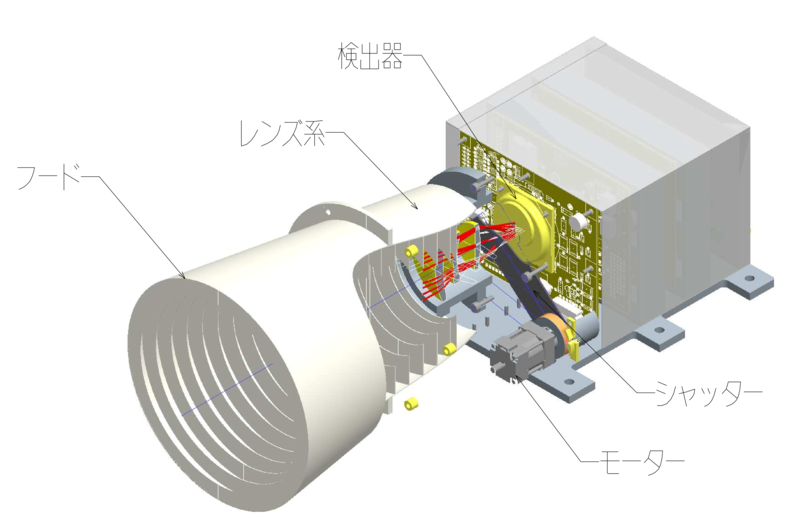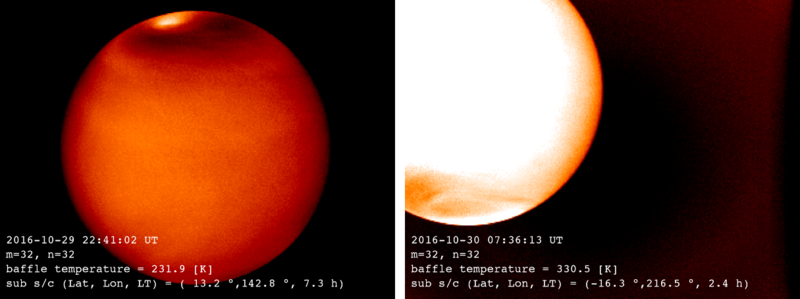Operation for obtaining calibration data of LIR
The Longwave Infrared Camera (LIR) captures thermal infrared radiation, which is emitted by any object at normal temperature. Since thermal infrared radiation is intensified as the temperature of an object increases, we can estimate the temperature of the object by measuring the brightness of infrared radiation emitted from it.

Figure 1. Structure and components of LIR © PLANET-C Project Team
One difficulty of measuring thermal infrared radiation is that an infrared camera itself also emits thermal infrared radiation which may be a noise source of an output signal. This is inevitable unless the camera is chilled at extremely low temperatures. Instead of cooling, the temperature of LIR is stabilized at a level as constant as possible so that noise due to internal infrared radiation is minimized. For example, thetemperature of the infrared detector, which is the most susceptible to temperature fluctuation, is stabilized at 40 ± 0.01℃.
The second strongest noise source is fromthe lens, and therefore, the lens temperature is kept constant by a feedback control system that consists of a temperature sensor and a heater. Actually the temperature sensor is installed not on the lens itself but on the lens mount to avoid blocking off the incidence light by the sensor.
LIR has sent more than 8,000 images down to the Earth since Akatsuki entered the orbit around Venus. However, close evaluation of the Venus temperatures derived from those images resulted in the unexpected discovery of temperature inhomogeneity and fluctuations. Further investigation revealed that the Venus temperature tends to increase as thetemperature of the LIR hood (Fig. 1) increases (Fig. 2).
Figure 2. Images of Venus taken by LIR when hood temperature was 57℃ (right) and -41℃ (left). When the hood temperature is high, the temperature of the Venus disk is higher across the board. © PLANET-C Project Team
The hood prevents sunlight from directly hitting the lens while LIR observes Venus. It may be illuminated by sunlight or shaded by the spacecraft's body as Akatsuki changes its attitude with respect to the Sun (Fig. 3). While the hood is designed to reflect sunlight, some is absorbed, which in turn heats the hood. The heated hood emits stronger thermal infrared radiation, some of which we believe is absorbed by the lens, thereby raising its temperature. The temperature of the lens mount where the temperature sensor is attached, is controlled by a heater to maintain constancy; however, we suspect that the temperature of the lens itself shifts due to changes in the thermal infrared radiation from the hood.
Figure 3. Changes in illumination of LIR hood by sunlight following attitude change of Akatsuki. The LIR hood is shown on the left image with a red circle. The LIR field of view looks down and to the right on a diagonal. The left, center, and right images are respectively lit by sunlight at 30°, 90°, and 180° off of LIR's field of view. In the case of 30°, sunlight covers part of the exterior and interior of the hood. In the case of 90°, sunlight only makes contact with the exterior of the hood. In the case of 180°, sunlight is occluded by the shadow of the Akatsuki's body and does not enter the hood. © PLANET-C Project Team
It is inevitable that the attitude of Akatsuki against the Sun varies during observation, which results in the change of hood temperature. Thus, we have devised a way to calibrate the data using the hood temperature. On September 21, 2016, observations were prohibited, because Venus was seen too close to the Sun from Akatsuki (period of prohibition of observation). In this period LIR took images of deep space by changing the attitude of Akatsuki so that the angle between the line-of-sight of LIR and direction to the Sun was set to every 15° from 30° to 120°. Since LIR cannot detect such weak thermal infrared radiation as emitted from deep space, the deep-space image should be completely black. However, when the lens is heated by the thermal radiation from the hood, thermal infrared radiation from the lens is detected in the image. Investigation of the obtained data revealed that there was a clear proportional relationship between the hood temperature at the time of image acquisition and apparent deep-space temperature derived from the LIR image. It is now believed that this relationship can be used to resolve the issue of the hood temperature affecting the images.
In order to obtain more detailed data than those obtained on September 21, 2016, LIR took deep-space images again during the period of prohibition of observation that began in mid-April 2017. This time, Akatsuki changed its attitude in a wider azimuthal range, and took more time between an attitude change and an image acquisition for stabilizing the temperatures than on the previous occasion. We expect that this deep-space observation will provide the complete supplementary data needed. The resultant data set allows us to further study a range of research topics using the LIR data, such as a comparison with the past atmospheric temperature observations and evaluation of the energy budget of Venus.
Makoto Taguchi (Rikkyo University)





